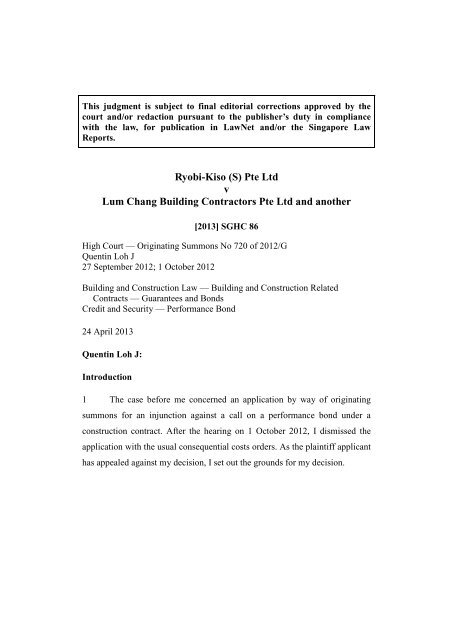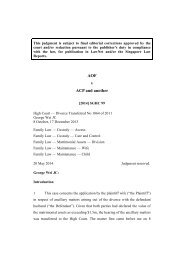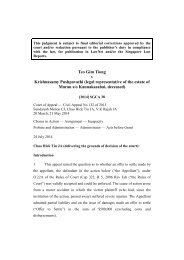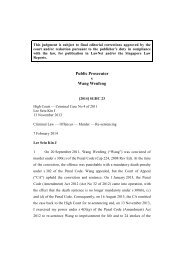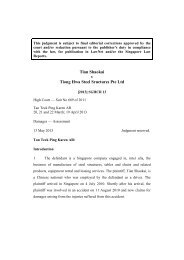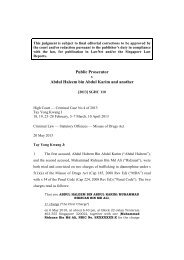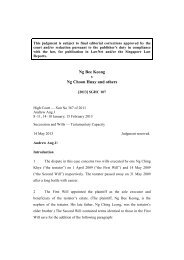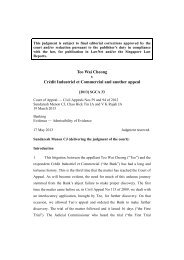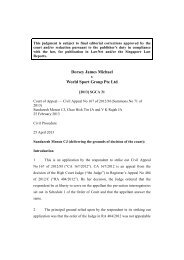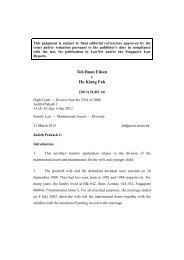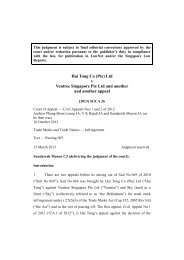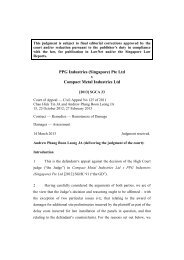Ryobi-Kiso (S) Pte Ltd v Lum Chang Building Contractors Pte Ltd and another
Ryobi-Kiso (S) Pte Ltd v Lum Chang Building Contractors Pte Ltd and another
Ryobi-Kiso (S) Pte Ltd v Lum Chang Building Contractors Pte Ltd and another
Create successful ePaper yourself
Turn your PDF publications into a flip-book with our unique Google optimized e-Paper software.
This judgment is subject to final editorial corrections approved by the<br />
court <strong>and</strong>/or redaction pursuant to the publisher’s duty in compliance<br />
with the law, for publication in LawNet <strong>and</strong>/or the Singapore Law<br />
Reports.<br />
<strong>Ryobi</strong>-<strong>Kiso</strong> (S) <strong>Pte</strong> <strong>Ltd</strong><br />
v<br />
<strong>Lum</strong> <strong>Chang</strong> <strong>Building</strong> <strong>Contractors</strong> <strong>Pte</strong> <strong>Ltd</strong> <strong>and</strong> <strong>another</strong><br />
[2013] SGHC 86<br />
High Court — Originating Summons No 720 of 2012/G<br />
Quentin Loh J<br />
27 September 2012; 1 October 2012<br />
<strong>Building</strong> <strong>and</strong> Construction Law — <strong>Building</strong> <strong>and</strong> Construction Related<br />
Contracts — Guarantees <strong>and</strong> Bonds<br />
Credit <strong>and</strong> Security — Performance Bond<br />
24 April 2013<br />
Quentin Loh J:<br />
Introduction<br />
1 The case before me concerned an application by way of originating<br />
summons for an injunction against a call on a performance bond under a<br />
construction contract. After the hearing on 1 October 2012, I dismissed the<br />
application with the usual consequential costs orders. As the plaintiff applicant<br />
has appealed against my decision, I set out the grounds for my decision.
<strong>Ryobi</strong>-<strong>Kiso</strong> (S) <strong>Pte</strong> <strong>Ltd</strong> v <strong>Lum</strong> <strong>Chang</strong> <strong>Building</strong> <strong>Contractors</strong><br />
<strong>Pte</strong> <strong>Ltd</strong> [2013] SGHC 86<br />
Facts<br />
The parties<br />
2 The plaintiff is a piling specialist (“the Plaintiff”) while the first<br />
defendant is a civil <strong>and</strong> building contractor (“the 1 st Defendant”). The second<br />
defendant is an insurance company (“the 2 nd Defendant”) which issued the<br />
performance bond that is the subject of this application.<br />
3 The 1 st Defendant is the main contractor for Contract 912 viz the<br />
“Design <strong>and</strong> Construction of Station at Bukit Panjang <strong>and</strong> Tunnels for<br />
Downtown Line Stage 2 at Woodl<strong>and</strong>s Road <strong>and</strong> Upper Bukit Timah”. The<br />
employer of the 1 st Defendant for Contract 912 is the L<strong>and</strong> Transport<br />
Authority (“LTA”), pursuant to a contract dated 17 June 2009 which the latter<br />
entered into with the 1 st Defendant (“the Main Contract”).<br />
4 The Plaintiff was engaged by the 1 st Defendant under a sub-contract<br />
dated 11 February 2010 (“the Sub-Contract”). The Sub-Contract was for part<br />
of the works under the Main Contract.<br />
The Performance Bond under the Sub-Contract<br />
5 Pursuant to cl 3(a) of the Sub-Contract, 1 the Plaintiff provided the 1 st<br />
Defendant with an unconditional performance bond in the sum of $1.88m<br />
which was issued by the 2 nd Defendant on 1 June 2010 (“the Performance<br />
1 Thung Chun Heng 1 st Affidavit at p 24.<br />
2
<strong>Ryobi</strong>-<strong>Kiso</strong> (S) <strong>Pte</strong> <strong>Ltd</strong> v <strong>Lum</strong> <strong>Chang</strong> <strong>Building</strong> <strong>Contractors</strong><br />
<strong>Pte</strong> <strong>Ltd</strong> [2013] SGHC 86<br />
Bond”). The Performance Bond was 10% of the Sub-Contract price of<br />
$18.8m.<br />
The Sub-Contract Works<br />
Donuts & Peanuts <strong>and</strong> Zone 2 Station Box<br />
6 The scope of the works covered by the Sub-Contract is detailed in cl 1<br />
of Part 1 of the Schedule in the Sub-Contract: 2<br />
The Sub-Contract Works to be executed by the Sub-<br />
Contractor shall be the Construction <strong>and</strong> Completion of<br />
Foundation, Kingposts/Deckposts, Secant <strong>and</strong> Contiguous<br />
Bored Piles for Station Box (known as “Zone 2”) <strong>and</strong> under<br />
BPLRT [Bukit Panjang Light Rail Transit] Viaduct (known as<br />
“Donuts & Peanuts”) to Downtown Line Stage 2 for Contract<br />
912 in compliance with the Sub-Contract <strong>and</strong> the Main<br />
Contract.<br />
In essence, the Sub-Contract scope of works shall be deemed<br />
to include, but not limited to, the following description of the<br />
major items:<br />
...<br />
The works therefore involved carrying out piling <strong>and</strong> associated works under<br />
the existing Bukit Panjang Light Rail <strong>and</strong> alongside or nearby busy road<br />
junctions <strong>and</strong> a station box for a future MRT line <strong>and</strong> station. The road<br />
junctions involved busy traffic intersections of Upper Bukit Timah,<br />
Woodl<strong>and</strong>s, Bukit Panjang <strong>and</strong> Choa Chu Kang Roads.<br />
7 I shall refer to the general scope of the Plaintiff’s works as “the Sub-<br />
Contract Works”. The two locations where the Sub-Contract Works were to be<br />
2 Thung Chun Heng 1 st Affidavit at p 49.<br />
3
<strong>Ryobi</strong>-<strong>Kiso</strong> (S) <strong>Pte</strong> <strong>Ltd</strong> v <strong>Lum</strong> <strong>Chang</strong> <strong>Building</strong> <strong>Contractors</strong><br />
<strong>Pte</strong> <strong>Ltd</strong> [2013] SGHC 86<br />
performed are described as Donut & Peanuts <strong>and</strong> Zone 2 Station Box. The<br />
completion times for the Sub-Contract Works are spelt out in Part 3 of the<br />
Schedule. 3 Work for Donuts & Peanuts was to be completed within 1 April<br />
2010 to 30 September 2010, while work for Zone 2 Station Box was to be<br />
completed within 1 March 2010 to 31 May 2011. Clause 5 of Part 3 of the<br />
Schedule sets out the liquidated damages for delay in completion of works for<br />
Donuts & Peanuts <strong>and</strong> Zone 2 Station Box.<br />
8 According to the 1 st Defendant, the works for Donuts & Peanuts <strong>and</strong><br />
Zone 2 Station Box exceeded the maximum time stipulated for completion by<br />
152 days <strong>and</strong> 332 days respectively. 4 If the Plaintiff is liable for the total<br />
number of days which exceeded the relevant completion dates, its total<br />
liability would be $7.26m. The 1 st Defendant’s Project Director filed an<br />
affidavit setting out the delays caused by the Plaintiffs. 5 These include delays<br />
in submitting Method Statements <strong>and</strong> drawings (which were required before<br />
approvals could be obtained from the various authorities for works to be<br />
carried out), poor planning <strong>and</strong> mobilisation, 3-months delay in the foregoing<br />
for the LTA Development & <strong>Building</strong> Control Division clearance for works<br />
under the Bukit Panjang Light Rail viaduct, using less powerful <strong>and</strong> slower<br />
low-headroom piling equipment where there were no headroom restrictions.<br />
Of course, the Plaintiff denied liability for the late completion. 6<br />
3 Thung Chun Heng 1 st Affidavit at p 53.<br />
4 Rintu Chakravarthy 1 st Affidavit at paras 29–30.<br />
5 Rintu Chakravarthy 1 st Affidavit at paras 9–30 <strong>and</strong> 32–37.<br />
6 Thung Chun Heng 2 nd Affidavit at pp 10–12.<br />
4
<strong>Ryobi</strong>-<strong>Kiso</strong> (S) <strong>Pte</strong> <strong>Ltd</strong> v <strong>Lum</strong> <strong>Chang</strong> <strong>Building</strong> <strong>Contractors</strong><br />
<strong>Pte</strong> <strong>Ltd</strong> [2013] SGHC 86<br />
Termination of the Sub-Contract <strong>and</strong> Stage 4 Works<br />
9 In or about May 2012, the 1 st Defendant’s project manager, Mr K S<br />
Rao (“Mr Rao”), called the Plaintiff twice, asking them to submit a<br />
programme for the next phase of the Sub-Contract Works (“the Stage 4<br />
Works”). 7 Under cl 22(a) of the Sub-Contract, 8 the Plaintiff was obliged to<br />
provide information, or programmes, of the arrangements <strong>and</strong> sequence which<br />
it proposed to adopt for the execution of the Sub-Contract Works. It should be<br />
noted that the 1 st Defendant had already previously asked the Plaintiff for such<br />
a programme, for instance, by a letter dated 12 April 2012. 9 The Plaintiff’s<br />
reply then was that pursuant to a letter by the 1 st Defendant dated 12 July 2011<br />
(“the 12 July 2011 Letter”), the Stage 4 Works had been deleted from the Sub-<br />
Contract Works. 10 A series of correspondence then followed in April in which<br />
the 1 st Defendant insisted that there was no deletion <strong>and</strong> the Plaintiff insisted<br />
the converse. 11 However, at the time of Mr Rao’s telephone calls, the Plaintiff<br />
stood by its position that it was not carrying out the Stage 4 Works as those<br />
works had been deleted from the Sub-Contract Works unless they were treated<br />
as a variation for which additional payment would be required (see [11]<br />
below).<br />
7 Rintu Chakravarthy 1 st Affidavit at para 42.<br />
8 Thung Chun Heng 1 st Affidavit at p 41.<br />
9 Rintu Chakravarthy 1 st Affidavit at p 83.<br />
10 Rintu Chakravarthy 1 st Affidavit at p 84.<br />
11 Rintu Chakravarthy 1 st Affidavit at pp 85–89.<br />
5
<strong>Ryobi</strong>-<strong>Kiso</strong> (S) <strong>Pte</strong> <strong>Ltd</strong> v <strong>Lum</strong> <strong>Chang</strong> <strong>Building</strong> <strong>Contractors</strong><br />
<strong>Pte</strong> <strong>Ltd</strong> [2013] SGHC 86<br />
10 I digress for the moment to explain the significance of the 12 July 2011<br />
Letter. That letter was sent by the 1 st Defendant to remind the Plaintiff to<br />
complete certain piles by 30 September 2011. This was just <strong>another</strong> letter in a<br />
series of letters from the 1 st Defendant to the Plaintiff recording the poor<br />
performance of the Plaintiff which was causing delays. The 12 July 2011<br />
Letter ended with: 12<br />
Lastly, please note that in order to reduce your load, we have<br />
piles in front of Ten Mile Junction be carried out (sic) by Zap<br />
Piling behalf (sic) of <strong>Ryobi</strong> <strong>Kiso</strong> to avoid further delay to the<br />
piling works <strong>and</strong> subsequent activity. ...<br />
[emphasis added]<br />
The Plaintiff treated the 1 st Defendant’s employment of Zap Piling <strong>Pte</strong> <strong>Ltd</strong><br />
(“ZPPL”) pursuant to the 12 July 2011 Letter to do part of the Sub-Contract<br />
Works as a breach of contract. 13 Nevertheless, the Plaintiff <strong>and</strong> ZPPL<br />
continued to carry out their respective parts of the Sub-Contract Works.<br />
11 However, some 10 months later, when it came to the Stage 4 Works<br />
(which were part of the Sub-contract Works), the Plaintiff told the 1 st<br />
Defendant that the scope of the Sub-Contract Works had been varied as a<br />
result of the 1 st Defendant’s employment of ZPPL such that the Stage 4 Works<br />
would be considered a variation for which additional payment was required. 14<br />
The Plaintiff forwarded to the 1 st Defendant its proposed quote <strong>and</strong> schedule<br />
of the programme for the Stage 4 Works on 4 June 2012 which showed that<br />
12 Thung Chun Heng 1 st Affidavit at p 187.<br />
13 Thung Chun Heng 1 st Affidavit at para 36.<br />
14 Thung Chun Heng 1 st Affidavit at para 46.<br />
6
<strong>Ryobi</strong>-<strong>Kiso</strong> (S) <strong>Pte</strong> <strong>Ltd</strong> v <strong>Lum</strong> <strong>Chang</strong> <strong>Building</strong> <strong>Contractors</strong><br />
<strong>Pte</strong> <strong>Ltd</strong> [2013] SGHC 86<br />
the works would extend to mid-August 2012. On the same day, the 1 st<br />
Defendant terminated the Sub-Contract with the Plaintiff. The Plaintiff<br />
commenced the first adjudication application on 7 June 2012 for security of<br />
payments of $5.37m as the total sum of Progress Payment No 27 under the<br />
Sub-Contract (“AA SOP 52”). The Plaintiff commenced a second adjudication<br />
application for <strong>another</strong> $4.52m in relation to payments for <strong>another</strong> subcontract<br />
relating to the construction of diaphragm walls (“AA SOP 53”). I shall refer to<br />
AA SOP 52 <strong>and</strong> AA SOP 53 collectively as “the Adjudications”.<br />
12 The 1 st Defendants point out that they were initially forced to take<br />
some work out of the Plaintiff’s h<strong>and</strong>s <strong>and</strong> engage ZPPL as the Plaintiff was<br />
seriously delayed in the performance of their obligations. When it came to the<br />
Stage 4 Works, it was due to commence on the 11 June 2012. There was a<br />
planned major road diversion, arranged with the various authorities, from 10<br />
June 2012 which involved the busy Upper Bukit Timah, Woodl<strong>and</strong>s, Bukit<br />
Panjang <strong>and</strong> Choa Chu Kang road junction. It appears that these works around<br />
this diversion had to be completed by July 2012. Yet, at this crucial point in<br />
time, according to the 1 st Defendant’s case, the Plaintiff held them to ransom<br />
by making a claim that the Stage 4 Works was a variation <strong>and</strong> which they said<br />
would extend into mid-August 2012.<br />
13 As a result of the above circumstances, the 1 st Defendant engaged<br />
ZPPL to do the Stage 4 Works. The contract with ZPPL was formally entered<br />
into on 24 July 2012 at a cost of $1.27m. 15 This was an additional $0.64m<br />
more than what the 1 st Defendant would have had to pay the Plaintiff had the<br />
15 Rintu Chakravarthy 1 st Affidavit at p 167.<br />
7
<strong>Ryobi</strong>-<strong>Kiso</strong> (S) <strong>Pte</strong> <strong>Ltd</strong> v <strong>Lum</strong> <strong>Chang</strong> <strong>Building</strong> <strong>Contractors</strong><br />
<strong>Pte</strong> <strong>Ltd</strong> [2013] SGHC 86<br />
latter performed the Stage 4 Works. 16 ZPPL appears to have completed the<br />
Stage 4 Works by 29 July 2012. 17<br />
Present proceedings – Originating Summons No 720 of 2012/G<br />
14 On 13 July 2012, the 1 st Defendant called on the Performance Bond<br />
(“the Call”) on the grounds of the Plaintiff’s breaches of the Sub-Contract. 18<br />
The Plaintiff then commenced these proceedings to restrain the 1 st Defendant<br />
from receiving the proceeds of the Call.<br />
15 On 27 July 2012, the Plaintiff commenced the present proceedings<br />
seeking, inter alia, a declaration that the 1 st Defendant be restrained from<br />
receiving payment under the Call, <strong>and</strong> that the 2 nd Defendant be restrained<br />
from making payment pursuant to the Call. I should just add that the<br />
substantive dispute(s) between the parties is subject to an ongoing arbitration<br />
which was commenced on 27 September 2012. When I dismissed the<br />
application, I did say to counsel that the substantive dispute(s) in this matter<br />
has to be resolved by arbitration.<br />
Parties’ respective cases<br />
Plaintiff’s case<br />
16 The Plaintiff contended that the Call was unconscionable as there was<br />
a genuine dispute as to whether the 1 st Defendant had breached the Sub-<br />
16 Rintu Chakravarthy 1 st Affidavit at p 176.<br />
17 Rintu Chakravarthy 1 st Affidavit at p 50.<br />
18 Rintu Chakravarthy 1 st Affidavit at para 5.<br />
8
<strong>Ryobi</strong>-<strong>Kiso</strong> (S) <strong>Pte</strong> <strong>Ltd</strong> v <strong>Lum</strong> <strong>Chang</strong> <strong>Building</strong> <strong>Contractors</strong><br />
<strong>Pte</strong> <strong>Ltd</strong> [2013] SGHC 86<br />
Contract either by removing part of the works under the Sub-Contract Works<br />
to be performed by ZPPL, or by terminating the Sub-Contract altogether. The<br />
Call, in the Plaintiff’s view, was not in good faith, clearly oppressive, <strong>and</strong><br />
should be construed as a bullying tactic. Even though the Plaintiff insisted that<br />
it did not know the reason why the 1 st Defendant issued the Call, 19 it<br />
speculated that the Call appears to be vindictive. The Plaintiff pointed to the<br />
decisions from the Adjudications on 10 <strong>and</strong> 12 July 2012 in which the 1 st<br />
Defendant was ordered to pay the Plaintiff $1.86m as a possible trigger for the<br />
Call which happened on 13 July 2012, the day after the second adjudication<br />
decision.<br />
1 st Defendant’s case<br />
17 The 1 st Defendant agreed that unconscionability is a ground upon<br />
which the court can grant an injunction restraining the beneficiary of a<br />
performance bond from calling on the bond. 20 However, it denied that it had<br />
acted unconscionably. The 1 st Defendant claimed that the Plaintiff’s<br />
allegations of, inter alia, bad faith, oppression, bullying, are speculative, bare<br />
<strong>and</strong> unsupported by evidence. On the 1 st Defendant’s part, they have exhibited<br />
evidence in relation to the Plaintiff’s delays <strong>and</strong> breaches. The 1 st Defendant’s<br />
case was that it did not breach the Sub-Contract by engaging ZPPL or by<br />
terminating the Sub-Contract. It pointed to the 12 July 2011 Letter where it<br />
was said that ZPPL would do the works on the Plaintiff’s behalf. As for<br />
termination, the 1 st Defendant contended that it did so because the Plaintiff<br />
19 Thung Chun Heng 1 st Affidavit at para 58.<br />
20 1 st Defendant’s submissions at para 5.<br />
9
<strong>Ryobi</strong>-<strong>Kiso</strong> (S) <strong>Pte</strong> <strong>Ltd</strong> v <strong>Lum</strong> <strong>Chang</strong> <strong>Building</strong> <strong>Contractors</strong><br />
<strong>Pte</strong> <strong>Ltd</strong> [2013] SGHC 86<br />
refused to carry out the Stage 4 Works. At the same time, the 1 st Defendant<br />
also pointed out that it had genuine claims against the Plaintiff in liquidated<br />
damages for late completion, the extra costs incurred by having to engage<br />
ZPPL, <strong>and</strong> overpayments made to the Plaintiff. 21 In these circumstances, the<br />
1 st Defendant was merely protecting its own interest by calling on the<br />
Performance Bond, 22 an act which was done bona fide.<br />
Grounds for my decision<br />
The relevant legal principles<br />
18 Whatever label the Plaintiff attached to the 1 st Defendant’s conduct in<br />
making the Call, it is clear that the Plaintiff’s case is founded on<br />
unconscionability. The concept of unconscionability in the context of<br />
restraining calls on performance bonds, as accepted in Singapore by the Court<br />
of Appeal in Dauphin Offshore Engineering & Trading <strong>Pte</strong> <strong>Ltd</strong> v The Private<br />
Office of HRH Sheikh Sultan bin Khalifa bin Zayed Al Nahyan [2000] 1<br />
SLR(R) 117 (“Dauphin Offshore”) at [45], involves:<br />
... unfairness, as distinct from dishonesty or fraud, or conduct<br />
of a kind so reprehensible or lacking in good faith that a court<br />
of conscience would either restrain the party or refuse to<br />
assist the party. Mere breaches of contract by the party in<br />
question ... would not by themselves be unconscionable. ...<br />
[emphasis in original]<br />
21 1 st Defendant’s submissions at para 19.<br />
22 1 st Defendant’s submissions at para 23.<br />
10
<strong>Ryobi</strong>-<strong>Kiso</strong> (S) <strong>Pte</strong> <strong>Ltd</strong> v <strong>Lum</strong> <strong>Chang</strong> <strong>Building</strong> <strong>Contractors</strong><br />
<strong>Pte</strong> <strong>Ltd</strong> [2013] SGHC 86<br />
19 Instances of when it would be considered unconscionable to call on a<br />
performance bond were helpfully summarised by the Court of Appeal in<br />
Dauphin Offshore (at [46]):<br />
... (a) in Kvaerner Singapore <strong>Pte</strong> <strong>Ltd</strong> v UDL Shipbuilding<br />
(Singapore) <strong>Pte</strong> <strong>Ltd</strong> ... the beneficiary made a call based on a<br />
breach induced by their own default <strong>and</strong> was not permitted to<br />
do so; (b) in Royal Design Studio <strong>Pte</strong> <strong>Ltd</strong> v <strong>Chang</strong> Development<br />
<strong>Pte</strong> <strong>Ltd</strong> ... an injunction was granted where the beneficiary's<br />
call on the bond was based on delays in construction that<br />
were caused by the beneficiary's own default in failing to make<br />
timely payments on the interim certificates issued by the<br />
architect <strong>and</strong> a considerable sum due to the account party<br />
under the joint venture agreement was retained by the<br />
beneficiary; (c) in Min Thai Holdings <strong>Pte</strong> <strong>Ltd</strong> v Sunlabel <strong>Pte</strong><br />
<strong>Ltd</strong> ... the defendant-buyer was restrained from calling on the<br />
performance guarantee when the non-delivery of rice was due<br />
to floods caused by typhoon <strong>and</strong> there was a “force majeure”<br />
clause in the contract, as the court felt that it was<br />
unconscionable, in the circumstances, for the defendantbuyer<br />
to receive payment under the performance guarantee.<br />
In the cases cited above where the call of the bond was considered<br />
unconscionable, either the beneficiary of the performance bond had by its own<br />
default contributed to the circumstances which founded the call, or both<br />
parties were wholly innocent. Evidently, it takes more than a mere default (ie<br />
mere breaches of contract) by the beneficiary to sustain an argument on<br />
unconscionability. In this regard, I note the high <strong>and</strong> strict st<strong>and</strong>ard of proof<br />
required of the applicant seeking the injunction which has been consistently<br />
applied by the Court of Appeal (Anwar Siraj <strong>and</strong> <strong>another</strong> v Teo Hee Lai<br />
<strong>Building</strong> Construction <strong>Pte</strong> <strong>Ltd</strong> [2003] 1 SLR(R) 394 at [11] citing Dauphin<br />
Offshore at [57]):<br />
... In Bocotra ... this court stated that “a high degree of<br />
strictness applies, as the applicant will be required to establish<br />
a clear case of fraud or unconscionability in the interlocutory<br />
proceedings. It is clear that mere allegations are insufficient”.<br />
11
<strong>Ryobi</strong>-<strong>Kiso</strong> (S) <strong>Pte</strong> <strong>Ltd</strong> v <strong>Lum</strong> <strong>Chang</strong> <strong>Building</strong> <strong>Contractors</strong><br />
<strong>Pte</strong> <strong>Ltd</strong> [2013] SGHC 86<br />
... In our opinion, what must be shown is a strong prima facie<br />
case of unconscionability. ...<br />
[emphasis in original omitted; emphasis added]<br />
20 That said, I am cognisant of the severity of calls on performance<br />
bonds, <strong>and</strong> how the court must be mindful of abuse. In GHL <strong>Pte</strong> <strong>Ltd</strong> v<br />
Unitrack <strong>Building</strong> Construction <strong>Pte</strong> <strong>Ltd</strong> <strong>and</strong> <strong>another</strong> [1999] 3 SLR(R) 44, the<br />
Court of Appeal said (at [24]):<br />
We agree that performance bonds are used frequently in the<br />
construction industry; that they are provided by <strong>and</strong> to parties<br />
who deal at arm's length; that the use of performance bonds<br />
has resulted in substantial benefits to the parties <strong>and</strong> also in<br />
savings; that the courts should give effect to the intention of<br />
the parties; <strong>and</strong> that the law in relation to performance bonds<br />
should be placed on “a clear <strong>and</strong> unambiguous footing” so<br />
that they could be accepted by parties whether in Singapore or<br />
abroad. But, with respect, these are not the points involved<br />
with which we are concerned. We are concerned with<br />
abusive calls on the performance bonds. It should not be<br />
forgotten that a performance bond can operate as an oppressive<br />
instrument, <strong>and</strong> in the event that a beneficiary calls on the bond<br />
in circumstances, where there is prima facie evidence of fraud<br />
or unconscionability, the court should step in to intervene at the<br />
interlocutory stage until the whole of the circumstances of the<br />
case has been investigated. It should also not be forgotten that<br />
a performance bond is basically a security for the performance<br />
of the main contract, <strong>and</strong> as such we see no reason, in<br />
principle, why it should be so sacrosanct <strong>and</strong> inviolate as not<br />
to be subject to the court's intervention except on the ground<br />
of fraud. We agree that a beneficiary under a performance<br />
bond should be protected as to the integrity of the security he<br />
has in case of non-performance by the party on whose<br />
account the performance bond was issued, but a temporary<br />
restraining order does not prejudice or adversely affect the<br />
security; it merely postpones the realisation of the security<br />
until the party concerned is given an opportunity to prove his<br />
case ...<br />
[emphasis added]<br />
21 Ultimately, the juridical basis for an injunction to restrain a<br />
performance bond on the ground of unconscionability lies in equity. The key<br />
12
<strong>Ryobi</strong>-<strong>Kiso</strong> (S) <strong>Pte</strong> <strong>Ltd</strong> v <strong>Lum</strong> <strong>Chang</strong> <strong>Building</strong> <strong>Contractors</strong><br />
<strong>Pte</strong> <strong>Ltd</strong> [2013] SGHC 86<br />
consideration in ascertaining whether a call on a performance bond should be<br />
restrained is achieving a fair balance between the interests of the beneficiary<br />
<strong>and</strong> those of the obligor: JBE Properties <strong>Pte</strong> <strong>Ltd</strong> v Gammon <strong>Pte</strong> <strong>Ltd</strong> [2011] 2<br />
SLR 47 at [13].<br />
Application of legal principles<br />
22 In the present case, having regard to what is a fair balance between the<br />
interests of the beneficiary 1 st Defendant <strong>and</strong> the obligor Plaintiff, I took the<br />
view that there was no unconscionability on the part of the 1 st Defendant in<br />
making the Call. The 1 st Defendant provided evidence to support its case, inter<br />
alia, that the Plaintiff was in serious delay, was using inappropriate equipment<br />
outside the appropriate reserve areas which slowed them down, were late in<br />
their submissions of Method Statements <strong>and</strong> drawings, had over-bored some<br />
holes <strong>and</strong> had gone far beyond the contract periods allowed for their Sub-<br />
Contract Works. Further, the 1 st Defendant showed that the Plaintiff had, in<br />
AA SOP 52, made an extravagant claim for of $5.37m for Progress Claim No<br />
27 as the adjudicator only determined a sum of $0.98m due (less than 20% of<br />
the claim). Whilst I am not making any decision on these allegations, it does<br />
appear to me that there were genuine construction disputes of the type that do<br />
arise in such contracts between the parties.<br />
Terms of the Performance Bond <strong>and</strong> Sub-Contract<br />
23 At the outset, I find that the Call falls squarely within the key terms of<br />
the Performance Bond read with the Sub-Contract. Clauses 1 <strong>and</strong> 2 of the<br />
Performance Bond provides that it is an unconditional bond which is payable<br />
on dem<strong>and</strong> by the 1 st Defendant:<br />
13
<strong>Ryobi</strong>-<strong>Kiso</strong> (S) <strong>Pte</strong> <strong>Ltd</strong> v <strong>Lum</strong> <strong>Chang</strong> <strong>Building</strong> <strong>Contractors</strong><br />
<strong>Pte</strong> <strong>Ltd</strong> [2013] SGHC 86<br />
1. The Insurer hereby unconditionally undertakes <strong>and</strong><br />
covenants to pay on dem<strong>and</strong> any sum or sums which may<br />
from time to time be dem<strong>and</strong>ed in writing by the Main<br />
Contractor ... to be held by the Main Contractor as security for<br />
<strong>and</strong> until the performance <strong>and</strong> completion by the Sub-<br />
Contractor of all the conditions of the Sub-Contract in all<br />
respects.<br />
2. The liability of the Insurer under this Deed shall not be<br />
discharged or impaired by reason of ... any breach or breaches<br />
of the Sub-Contract by the Sub-Contractor...<br />
[emphasis added]<br />
24 Clause 5 further provides:<br />
... The Insurer shall be under no duty to inquire into the<br />
reasons, circumstances or authenticity of the grounds for<br />
such claim or direction...<br />
25 Clause 3(c) of Sub-Contract provides the purpose for which the<br />
proceeds of the Performance Bond may be utilised: 23<br />
(c) The Main Contractor may utilise the cash deposit or the<br />
proceeds of any call or dem<strong>and</strong> on the performance bond to<br />
make good any loss or damage sustained or likely to be<br />
sustained by the Main Contractor as a result of any<br />
breach whatsoever of this Sub-Contract by the Sub-<br />
Contractor or the termination of the employment of Sub-<br />
Contractor, including any liquidated damages or any sum<br />
due to the Main Contractor under clause 18 of these Sub-<br />
Contract Conditions.<br />
[emphasis added in italics <strong>and</strong> bold italics]<br />
26 The 1 st Defendant has compiled a list of its losses which it says it has<br />
suffered as a result of, inter alia, the Plaintiff’s delays in the performance of<br />
the Sub-Contract Works <strong>and</strong> refusal to perform the Stage 4 Works. The total<br />
23 Thung Chun Heng 1 st Affidavit at p 24.<br />
14
<strong>Ryobi</strong>-<strong>Kiso</strong> (S) <strong>Pte</strong> <strong>Ltd</strong> v <strong>Lum</strong> <strong>Chang</strong> <strong>Building</strong> <strong>Contractors</strong><br />
<strong>Pte</strong> <strong>Ltd</strong> [2013] SGHC 86<br />
value of these losses, $8.59m, far outstrips the value of the Performance Bond<br />
viz $1.88m. Based on the particulars provided in the 1 st Defendant’s affidavit<br />
evidence, there is no reason for me to disbelief the accuracy of the 1 st<br />
Defendant’s quantification of its losses. The Plaintiff has alleged that some of<br />
these losses, such as the liquidated damages claims, have not crystallised as<br />
there is no evidence that the LTA has claimed liquidated damages from the 1 st<br />
Defendant. Be that as it may, cl 3(c) explicitly states that the performance<br />
bond may be used to make good not just losses that have been sustained, but<br />
also losses that are “likely to be sustained”. Given that the works were indeed<br />
delayed, <strong>and</strong> that the LTA did not grant any extensions of time, 24 there was no<br />
basis for me to infer that the 1 st Defendant was not likely to be exposed to a<br />
claim for liquidated damages from the LTA.<br />
Unconscionability<br />
27 Certainly, notwithst<strong>and</strong>ing the terms of the Performance Bond <strong>and</strong> the<br />
Sub-Contract, if the Call was actuated under unconscionable circumstances, it<br />
may still be restrained. However, I was not convinced that the making of the<br />
Call was unconscionable.<br />
28 The Plaintiff’s allegations of bad faith, oppression, bullying by the 1 st<br />
Defendant are, even by the Plaintiff’s own case, guesswork. This plainly fails<br />
the high <strong>and</strong> strict st<strong>and</strong>ard of proof required of the Plaintiff applicant of the<br />
injunction. The strongest allegation by the Plaintiff, viz, that the Call was a<br />
retaliatory move by the 1 st Defendant following the decision of the adjudicator<br />
24 Rintu Chakravarthy 1 st Affidavit at para 39.<br />
15
<strong>Ryobi</strong>-<strong>Kiso</strong> (S) <strong>Pte</strong> <strong>Ltd</strong> v <strong>Lum</strong> <strong>Chang</strong> <strong>Building</strong> <strong>Contractors</strong><br />
<strong>Pte</strong> <strong>Ltd</strong> [2013] SGHC 86<br />
in the Adjudications to award the Plaintiff a total of $1.86m, was<br />
unsubstantiated. While the timing of the Call calls for closer scrutiny, that<br />
alone cannot support a claim of unconscionable conduct. More evidence is<br />
required. On that premise, I did not find the circumstances, particularly the<br />
conduct of the 1 st Defendant in the lead up to the Call, to be, in the words of<br />
the Court of Appeal in Dauphin Offshore, so “reprehensible or lacking in good<br />
faith” (see [18] above).<br />
29 First, I did not accept that the 1 st Defendant’s engagement of ZPPL or<br />
the subsequent termination of the Sub-Contract was unfair or lacking in good<br />
faith. While I am not making a judgment on the merits of whether the Plaintiff<br />
or 1 st Defendant had through their respective actions breached the Sub-<br />
Contract, I would nevertheless state that on the facts, the 1 st Defendant was, as<br />
a rational business-minded party, commercially justified in engaging ZPPL to<br />
perform a portion of the Sub-Contract Works in the light of the Plaintiff’s<br />
numerous <strong>and</strong> repeated delays in completing the works at Donuts & Peanuts<br />
<strong>and</strong> Zone 2 Station Box. I also bear in mind the obvious restrictions working<br />
around an existing viaduct carrying the Bukit Panjang Light Rail <strong>and</strong> the large<br />
traffic junctions <strong>and</strong> the obvious difficulties in obtaining traffic diversion<br />
clearances which would have been subject to strict periods of diversion. I<br />
shall refer to a h<strong>and</strong>ful of correspondence which is representative of the<br />
genuine frustration that the 1 st Defendant was experiencing prior to the Call as<br />
a result of what it perceived to be the Plaintiff’s untimely performance of its<br />
obligations.<br />
16
<strong>Ryobi</strong>-<strong>Kiso</strong> (S) <strong>Pte</strong> <strong>Ltd</strong> v <strong>Lum</strong> <strong>Chang</strong> <strong>Building</strong> <strong>Contractors</strong><br />
<strong>Pte</strong> <strong>Ltd</strong> [2013] SGHC 86<br />
30 The 1 st Defendant (either directly or through their solicitors) had<br />
written to the Plaintiff on the following occasions, highlighting the former’s<br />
concerns over the latter’s delays <strong>and</strong> the consequences of those delays:<br />
28 February 2011 25<br />
... You were thus 147 calendar days late in completing this<br />
section [Donuts & Peanuts] of your work, making you liable<br />
for a total Liquidated Damages sum of $2,205,000.00. We<br />
record that your late completions were entirely of your own<br />
making <strong>and</strong> were due to, but not limited to, the following<br />
reasons ...<br />
9 April 2011 26<br />
We would like to bring to your attention the delay in<br />
completion of piling work at Zone 2 (West) ... As a result, the<br />
overall completion of the piling schedule for Zone 2 weste has<br />
been delayed since 25 March 2011 ... All of the above delays<br />
are accumulating <strong>and</strong> affecting our traffic diversion work. As<br />
such, we shall hold you directly responsible for these delays.<br />
16 June 2011 27<br />
... We have recorded many delays you have caused due to poor<br />
performance, poor management, inadequate equipment <strong>and</strong><br />
low productivity <strong>and</strong> hold you responsible for the subsequent<br />
delays ...<br />
29 May 2012 28<br />
... Kindly note that the timely progress of works on site is<br />
crucial <strong>and</strong> our clients [1 st Defendant] are subject to extensive<br />
liquidated damages for delay. If such damages are imposed on<br />
our clients as the result of your clients’ [Plaintiff] refusal to<br />
comply with the obligations under the Contract, our clients<br />
will not hesitate to claim such damages together with any<br />
other consequential losses against your clients. ...<br />
25 Rintu Chakravarthy 1 st Affidavit at pp 65–66.<br />
26 Rintu Chakravarthy 1 st Affidavit at p 75.<br />
27 Rintu Chakravarthy 1 st Affidavit at p 76.<br />
28 Rintu Chakravarthy 1 st Affidavit at pp 96–97.<br />
17
<strong>Ryobi</strong>-<strong>Kiso</strong> (S) <strong>Pte</strong> <strong>Ltd</strong> v <strong>Lum</strong> <strong>Chang</strong> <strong>Building</strong> <strong>Contractors</strong><br />
<strong>Pte</strong> <strong>Ltd</strong> [2013] SGHC 86<br />
These pieces of correspondence, which are by no means exhaustive,<br />
demonstrate that the 1 st Defendant had consistently taken the view that the<br />
Plaintiff was not meeting its obligations on time, <strong>and</strong> that the Plaintiff was<br />
liable to the 1 st Defendant for the consequences of delayed completion. The 1 st<br />
Defendant’s engagement of ZPPL to carry out the piling works on behalf of<br />
the Plaintiff (see [10] above) <strong>and</strong> termination of the Sub-Contract following<br />
the Plaintiff’s refusal to perform the Stage 4 Works must be seen in this<br />
context, as must the Call.<br />
31 Secondly, it ought also to be mentioned that the Plaintiff’s allegation 29<br />
– that the 1 st Defendant’s conduct in disallowing the Plaintiff’s extension of<br />
time claims is evidence of the 1 st Defendant’s bad faith – is contrary to the<br />
evidence before me. The Plaintiff’s claims for extension of time in its Claim<br />
Report dated 3 May 2011 (“the Claim Report”) were not accompanied with<br />
the relevant details, <strong>and</strong> despite being given time by the 1 st Defendant to<br />
substantiate its Claim Report, the Plaintiff did not appear to have submitted<br />
any further details. This was not the first time that the Plaintiff was reminded<br />
to substantiate its claims for extension of time. 30 In any event, the 1 st<br />
Defendant had evaluated the Claim Report <strong>and</strong> found that the Plaintiff was not<br />
entitled for extension of time for all 16 items in the Claim Report. 31<br />
32 Thirdly, in the face of the Plaintiff’s insistence initially on not<br />
performing the Stage 4 Works <strong>and</strong> subsequently only on the condition that<br />
29 Thung Chun Heng 2 nd Affidavit at para 42.<br />
30 Rintu Chakravarthy 1 st Affidavit at pp 67–74.<br />
31 Thung Chun Heng 2 nd Affidavit at pp 34–36.<br />
18
<strong>Ryobi</strong>-<strong>Kiso</strong> (S) <strong>Pte</strong> <strong>Ltd</strong> v <strong>Lum</strong> <strong>Chang</strong> <strong>Building</strong> <strong>Contractors</strong><br />
<strong>Pte</strong> <strong>Ltd</strong> [2013] SGHC 86<br />
those works would constitute a variation, the 1 st Defendant could reasonably<br />
have taken the view that it was entitled to terminate the Sub-Contract. Even if<br />
the 1 st Defendant was misapprehended <strong>and</strong> had wrongfully terminated the<br />
Sub-Contract, the law is clear that generally mere breaches of contract by the<br />
beneficiary of the performance bond are not, by themselves, unconscionable:<br />
Raymond Construction <strong>Pte</strong> <strong>Ltd</strong> v Low Yang Tong [1996] SGHC 136 at [5].<br />
33 Fourthly, even if I had accepted (which I do not) the Call was indeed a<br />
“retaliation” by the 1 st Defendant following the outcome of the Adjudications,<br />
the fact is that the 1 st Defendant was entitled to exercise the Call in<br />
consequence of its view that the Plaintiff had breached the Sub-Contract. The<br />
Plaintiff did not bring to my attention any authority which st<strong>and</strong>s for a<br />
proposition that even if a beneficiary is ordinarily entitled to call on a<br />
performance bond, it would be unconscionable to do so after the beneficiary<br />
has been ordered to pay certain sums to the obligor for other matters arising<br />
out of the same contractual relationship. In fact, I cannot see how a call on a<br />
performance bond in such circumstances can be considered to be so<br />
reprehensible. Taking the Plaintiff’s argument to its logical conclusion, the<br />
beneficiary’s right to call on a performance bond is extremely restricted. Not<br />
only would it be unconscionable if it the call is made after the beneficiary has<br />
been ordered to pay certain sums to the obligor, it could also be<br />
unconscionable before such sums were ordered. As long as the obligor had<br />
taken some steps to claim certain sums or payments from the beneficiary, the<br />
obligor would, if the Plaintiff’s proposition is accepted, be equally justified in<br />
asserting that a call then by the beneficiary would be unconscionable on the<br />
basis that it is “retaliatory” for the potential sums which the beneficiary might<br />
be liable to pay the obligor. I cannot think this is correct.<br />
19
<strong>Ryobi</strong>-<strong>Kiso</strong> (S) <strong>Pte</strong> <strong>Ltd</strong> v <strong>Lum</strong> <strong>Chang</strong> <strong>Building</strong> <strong>Contractors</strong><br />
<strong>Pte</strong> <strong>Ltd</strong> [2013] SGHC 86<br />
34 Finally, I st<strong>and</strong> guided by the Court of Appeal’s holding in BS Mount<br />
Sophia <strong>Pte</strong> <strong>Ltd</strong> v Join-Aim <strong>Pte</strong> <strong>Ltd</strong> [2012] 3 SLR 352 (“BS Mount Sophia”) at<br />
[37]:<br />
If the beneficiary's call on the bond is motivated by improper<br />
purposes, or such a call cannot be justified with clear<br />
evidence; or in any other situation where the beneficiary is<br />
less than certain about his entitlement to call on<br />
the bond <strong>and</strong> for what amount, the beneficiary ought to<br />
take a step back <strong>and</strong> re-examine its entitlement <strong>and</strong> conduct<br />
prior to calling on the bond. Unfairness is also an element of<br />
unconscionability (see below at [42]-[43]), <strong>and</strong> the question as<br />
to whether or not notice was afforded to the obligor of his<br />
alleged breach before the beneficiary's call on the bond would<br />
also be a relevant consideration. [emphasis added in italics<br />
<strong>and</strong> bold italics]<br />
In my view <strong>and</strong> in the light of the context which I have illustrated above, the<br />
1 st Defendant’s conduct clearly did not fall into any of the above categories of<br />
potentially unconscionable conduct.<br />
Conclusion<br />
35 In sum, the Plaintiff did not even adduce a prima facie strong piece of<br />
evidence illustrative of the 1 st Defendant’s unconscionable conduct, much less<br />
a strong prima facie case required of it to justify the restraining of the Call<br />
(see BS Mount Sophia at [40]). Having regard to the overall tenor <strong>and</strong> context<br />
of the entire conduct of the parties, I am unable to conclude that the 1 st<br />
Defendant’s conduct was “so lacking in bona fides” (see BS Mount Sophia at<br />
[45]). I therefore dismissed the Plaintiff’s application with costs.<br />
36 I need only add, as a postscript, that in an unsuccessful application for<br />
a stay of the release of the monies under the Performance Bond pending<br />
appeal, Mr Irving Choh, counsel for the Plaintiff, very properly accepted that<br />
20
<strong>Ryobi</strong>-<strong>Kiso</strong> (S) <strong>Pte</strong> <strong>Ltd</strong> v <strong>Lum</strong> <strong>Chang</strong> <strong>Building</strong> <strong>Contractors</strong><br />
<strong>Pte</strong> <strong>Ltd</strong> [2013] SGHC 86<br />
he could not in good conscience submit to me that if his client succeeds in its<br />
appeal, there would be a risk that his client could not recover the sum paid out<br />
under the Performance Bond.<br />
Quentin Loh<br />
Judge<br />
Irving Choh <strong>and</strong> Lim Bee Li (RHTLAW Taylor Wessing LLP) for<br />
the Plaintiff;<br />
Chew Yee Teck Eric (JLim & Chew Law Corporation) for the 1 st<br />
Defendant.<br />
21


